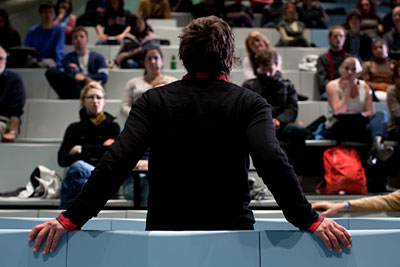'Streetfilms' showcase the benefits of livable streets
By Paul Bennetch

Making towns and cities more bike-friendly and less car-dependent not only increases urban safety, but also reinvigorates the local economy, saves money, promotes healthy living and strengthens social ties within the community, according to the films of "livable streets" advocacy organization Streetfilms.
An hour of the best Streetfilms were shown for "Monday Night at the Movies: Documenting the Livable Streets Movement," April 9 in Milstein Auditorium, with Streetfilms media-maker Elizabeth Press, and Streetsblog editor Ben Fried on hand to answer questions after the screening. The event was sponsored by the Department of City and Regional Planning (CRP) and the Rose Goldsen Lecture Series/Society for the Humanities.
John Foote, CRP visiting lecturer, said that New York City-based "Streetfilms and its sister organization Streetsblog have become the authoritative voice ... around the world with respect to alternative transportation, sustainable transportation and 'livable streets' ... using new media as an information tool an education tool and an advocacy tool to effect change to make our world a better place."
Most of the films were about "transportation best practices," as Press called them, from around the world, showcasing alternatives to America's car-dominated urban transportation systems.
One recurring theme in the films was to rearrange "street space" to better suit the needs of the local population -- such as creating bike paths or pedestrian plazas. The video "People, Parklets and Pavement to Parks," for example, showed how San Francisco converted street parking spots into an outdoor coffee shop sitting area, and an underutilized street into an urban park.
Another film showed how an old, nearly defunct industrial railway that cut through the heart of Minneapolis was turned into a "green" highway with biking pit stops and "exits," making bicycling the fastest mode of transportation to cross the city.
The films also emphasized the benefits of increasing urban bicycling and pedestrian space in addition to fewer automobile accidents. When there's less car traffic, streets become more accessible to pedestrians and vehicles, which helps boost foot traffic for businesses and housing values.
When asked how Streetfilms and Streetsblog can reach communities beyond such urban centers as New York City or San Francisco with their message, Press responded, "You would be quite surprised" about the number of people from "the middle of the country" showing interest in the livable streets movement.
"We're constantly getting orders from all over the country and all over the world, so people are getting these films and showing them to their elected officials to try to make changes," Press said. "There's a tremendous amount of distribution that happens without us even knowing about it at all," Fried added.
Earlier Monday afternoon, Fried and Press met with Foote's transportation policy class, and then each led half of an open workshop titled "Blogs... Camera... Action! Advocacy Through Interactive Media: Using Blogging and Web Video to Effect Change" in 213 Kennedy Hall. The workshop was sponsored by the Departments of City and Regional Planning and of Communication.
Media Contact
Get Cornell news delivered right to your inbox.
Subscribe